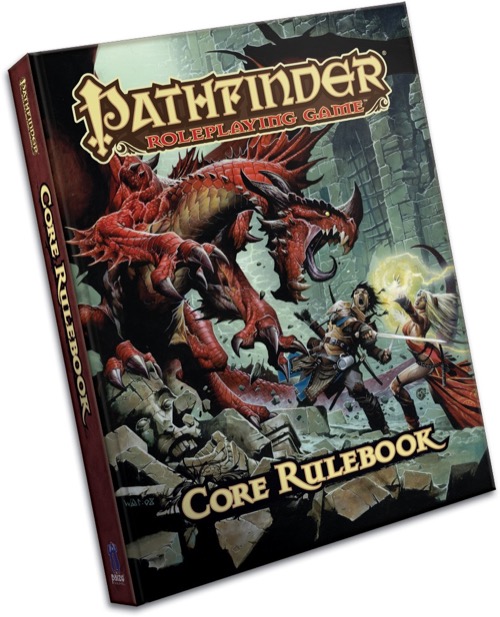
As a buyer for a games distributor, I have a lot of RPG books sitting in my office. Some new stuff we’re considering carrying, or starting to carry, some old stuff we don’t carry anymore, and some samples of games we never carried (and often for good reason). However, the newest addition to that shelf was sent to me personally by my contact at Paizo Publishing. An advance copy of the
Pathfinder RPG. This game doesn’t hit the streets until August 13th, so I am honored and excited to have a copy in my hands now. And the best part is, it’s mine! Not work’s. Mine. I get to take it home!
So, I’ve had this book for almost a week, and have really only had the chance to sit down with it in short increments. But what I have seen, added to what I had known about it before this printing, has impressed me greatly. So much so, that I now kind of regret spending the money on my 4E Core Rulebook Set (even though I got a great discount through work).
For starters, it just looks like
real D&D. This is important to me. I have been playing the game since I was 13. I started with the red box that had one rulebook,
B2: Keep on the Borderlands, some dice and a white crayon to color the numbers on those dice in with. I went on to Add the Expert Set, convert to AD&D, then to 2nd Edition, 3E and 3.5E. Then came 4E.
But wait, what happened here?
Don’t get me wrong, I like 4E. It’s pretty smooth, and makes for some really heroic gaming. But there is something about it that doesn’t feel quite right. That doesn’t feel
natural. Then it hits me. 4E is not the next step in the evolution of D&D. It’s a bastardization of D&D and the MMO. It’s like 3E and WoW had a love-child. The rules are scrubbed clean, and almost squeak with their precision and preciseness. You can practically hear the keyboard’s click-clack as you choose which power to use each round, and you can almost see your status bar drop when you get hit. 4E is a great game for people who have never played D&D before, or who are infatuated with computer and console RPGs. But for veterans like me who prefer a tabletop and live interaction, it doesn’t do the game justice.
Enter Pathfinder. Based on the 3.5 rules, Pathfinder takes what has been worked and tweaked and modified by house rules for the previous 8 years or so (5 years for 3.5), and takes the next step. By cleaning up the existing rules, adding new details to expand on those rules, and putting together a book that actually looks and feels more like D&D of old, they have created a new RPG that is grounded in the long-standing traditions of D&D, while reaching into new territory and creating new ideas. It feels, at first look, like what 4E should have been.
Even the physical look is more D&D, and less MMO. Gone are the spikey/pointy/edgy weapons and armor. In their place are more traditional looking costumes and characters, albeit with updated details. The pages aren’t white with color-coded boxes that remind me so much of my spreadsheets at work. They’re “old paper” colored, with artistic borders and text that doesn’t look like a textbook.
But one of my favorite features is that the core rules are included in one single book, rather than three. True, in September they will be releasing the
Bestiary, so a good GM will eventually need that book as well. But for now, he won’t. Which leads me to the best part about Pathfinder. You know all of those 3E and 3.5E supplements you spent your hard-earned money on that are now obsolete with 4E? Well, they are nearly 100% compatible with Pathfinder, with a minimal amount of adjustment.
Bear in mind, this is my initial impression. And it will take some playing and reading (though I have never in my life read any RPG book cover to cover), before I can really get into the nuances and changes in Pathfinder. But for now I’m actually really excited about it. And I haven’t been this excited about an RPG in a long time. I almost feel like I’m 13 again.
 Ok, so now that I have had a chance to read a bit more of the book, I’ll touch on a couple of points of change.
Ok, so now that I have had a chance to read a bit more of the book, I’ll touch on a couple of points of change.